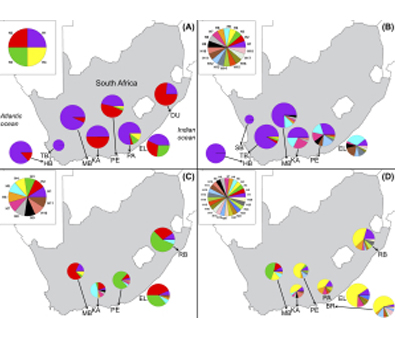We are broadly interested in the ecological and evolutionary mechanisms that determine species ranges and maintain populations within these ranges. Our research includes genetics, community ecology, biogeography, and conservation biology, with a special focus on marine ecosystems.
Our six sections
1. Genetics and colonisation
The ever-increasing environmental impacts derived from human activities have extensively modified evolutionary trajectories of populations across species ranges. Biological invasions are both direct and indirect consequences of such large-scale anthropogenic impacts, and constitute a crucial factor shaping biodiversity and biogeographic patterns worldwide. There is growing recognition that biological invasions are often extremely complex due to the high prevalence of multiple sources and non-independent introductions. However, the relative importance of the trade-off between losses of genetic diversity due to bottleneck processes during colonisation, and high genetic diversity as a result of multiple origins or introduction events, remains to be fully understood. In order to track routes of invasion of a widely distributed species, we have developed new molecular tools and implemented innovative analytical techniques that allow contrasting a wide range of complex scenarios.
General questions include:
– Can the native range be reliably identified? If so, is genetic admixture responsible for the genetic composition of the introduced range?
– Are colonisations generally non-independent?
– In what sequence have introduced populations been colonised?
– Are genetically-diverse populations a result of a single introduction of a large number of genetically heterogeneous individuals, or of recurrent introductions?
Relevant publications:
2. Naturalisation of non-indigenous species
The mechanisms that determine the introduction, establishment and spread of non-indigenous species can only be correctly interpreted by first obtaining rigorous historical data. In addition, acquiring ecological data on life-history traits within its introduced range is vital to understand relevant key characteristics of the invasion process such as generation time and adaptive phenotypic plasticity. We have assessed the magnitude and characteristics of marine and estuarine introductions along coastlines using both a regional and global approach.
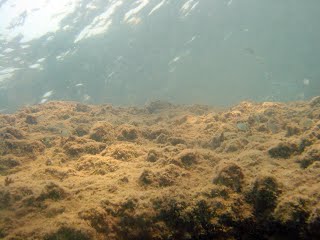
Substratum dominated by the introduced ascidian
Microcosmus squamiger in the Mediterranean Sea
Relevant publications:
Airoldi et al. 2015.Diversity and Distributions pdf
Mead et al. 2011.Journal of Natural History pdf
Rius & Griffiths 2011.Book chapter pdf
Mead et al. 2011.Biological Invasions pdf
Rius et al. 2009.Biological Invasions pdf
Turon et al. 2007.Journal of Experimental Marine Biology and Ecology pdf
Robinson et al. 2005.African Journal of Marine Science pdf
3. Evolutionary history and speciation
Many of the world’s coastal regions contain a large proportion of marine species that cannot be clearly identified due to a lack of systematic, biogeographical and historical evidence. The increasing availability of DNA sequence data has improved this situation, resulting in an increase in the identification of cryptic biodiversity.
We combined a morphological analysis with genetic data to unravel cryptic speciation within a widespread species complex that is highly abundant along temperate coastal regions of the southern hemisphere, namely the Pyura stolonifera species complex. This species complex is popularly known as cunjevoi in Australia and as redbait in South Africa.
Our research has revealed that in Australasia this complex comprises three species (two new to science) that are both morphologically and genetically distinct, and not one species (Pyura praeputialis) as previously thought. This work has been highlighted in both scientific and popular articles, including a piece entitled ‘Molecular view reassesses species’ published in Frontiers in Ecology and Environment, where the controversial topic of species delimitation is discussed and framed around the assessment and conservation of global biodiversity.
Relevant publications:
4. Ecological processes across multiple life-history stages
Most organisms have complex life-cycles whereby individuals undergo dramatic developmental transitions before reaching adulthood.
While studies have investigated key community traits such as biotic resistance during adult stages, there is little understanding of the relative importance of processes affecting early life-history stages and their carry-over effects. we found that lethal and non-lethal effects on early life-history stages can determine the viability of adults of native sessile species. In addition, we studied selection pressures in a species with complex life-cycles, in which mothers must balance the fecundity costs of increasing propagule size with the fitness benefits of increased propagule performance.
Questions addressed include:
– Are settlement preferences a good predictor of adult field distribution?
– Is biotic resistance occurring evenly across multiple life-history stages?
– Are offspring size effects consistent across the entire life cycle?

Larva of Pyura herdmani obtained by artificial fertilization in the laboratory
Relevant publications:
5. Community ecology
Studies on species interactions have traditionally focused on negative interactions such as competition and predation, but there is increasing recognition that positive interactions are more important than previously thought. We have conducted experiments assessing the relative role of competition and facilitation in determining the distribution of marine foundation species. In addition, and considering that abiotic stresses can directly influence the outcome of species interactions, we analyzed species interactions along gradients of conditions.
The results untangled the influence of abiotic factors in mediating biotic interactions and coexistence between newcomers and well-established species. Through this work we addressed questions such as:
– Are positive and negative interactions temporally and spatially partitioned?
– How are species interactions maintained over long periods?
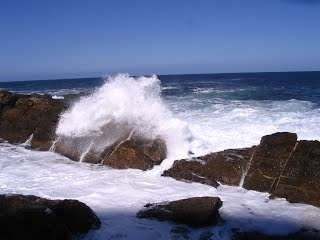
Wave action is one of the primary causes of disturbance
on rocky shores, often preventing dominant competitors
from monopolizing primary space
6. Marine conservation
Marine Protected Areas (MPAs) are crucial for conservation biology and management. Most studies of MPAs focus on the recovery of top predators with fewer studies focusing on lower trophic level organisms. In my early work, we assessed the impact of recreational exploitation along protected and non-protected coastlines in southern Europe, as well as how inaccessible or formally protected areas are beneficial to the recovery of exploited populations. In South Africa, we studied how ancestral subsistence exploitation is reconciled with modern day conservation enforcement.
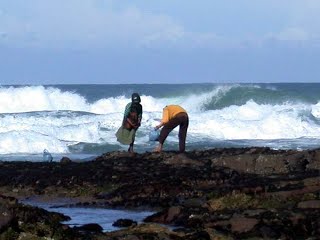
Human harvesting is an ancestral activity
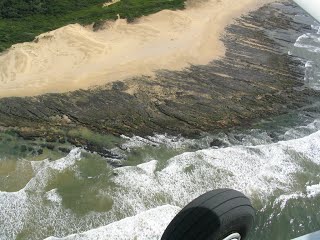
Aerial surveys along the South African coast to assess patterns of exploitation pressure


